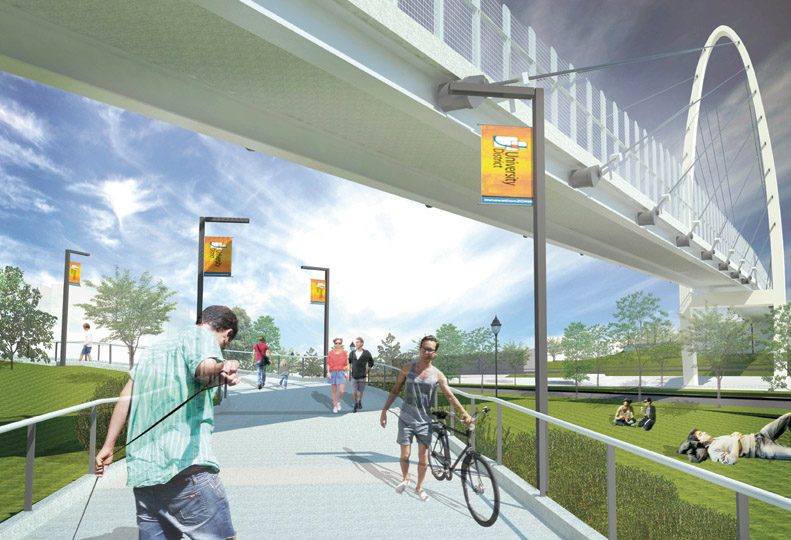Spanning the district
Gateway Bridge project seen as East Sprague spark

Now that funding is committed to erect the long-envisioned $15.4 million University District pedestrian bridge, the next step is to coordinate public and private development to maximize the critical access link, says Mark Mansfield, the new Spokane University District executive director.
Mansfield took the roll of the first full-time U-District executive director last month. His responsibilities include guiding project development and strategy, and serving as a liaison for the district to the city of Spokane and other government agencies.
“The Gateway Bridge is the lynchpin for all sorts of different developments,” Mansfield says of the East Sprague neighborhood on the south side of the U-District. “The project will open it in a way that hasn’t existed before.”
The bridge will span Martin Luther King Jr. Way and the BNSF Railway Co. tracks, providing a connection between the East Sprague neighborhood and the Riverpoint campus.
The Gateway Bridge likely will go out for construction bids next year and is expected to be completed in 2018.
Mansfield says the bridge will be a critical link between higher-education facilities and the medical district along Spokane’s lower South Hill. With that in mind, plans also are under way to connect a medical-district shuttle on the south side bridge and the Spokane Transit Authority’s envisioned Central City Line near the north landing, he says.
The state transportation budget includes $8.8 million for the project, completing the funding needed to start construction.
“The engineering is complete, the bridge is designed, and it’s been through the public process,” Mansfield says.
The city also has purchased about 20 parcels of land north of Sprague Avenue along an unimproved portion of Riverside Avenue, where the south landing of the bridge will be constructed, he says.
The next formality is in obtaining right of way over the railroad tracks.
“It’s not a hurdle, just a logistic,” Mansfield says. “It couldn’t be done until funding was secure.”
He says now that the bridge project is nearly shovel ready, it should be coordinated with other public and private development to extend the “path to opportunity” beyond the bridge landings.
Andrew Worlock, the city’s planning staff representative to the University District, says the rest of the funds are committed through a state grant earmarked for the U-District and through other local sources.
Worlock says the city’s engineering staff will handle the bridge project, as it does with most of the city’s public works projects.
Now that the project is a go, the city also wants to coordinate the construction timing with other public works and private development that might occur around the bridge, Worlock says.
He says he’s hearing of potential development interest from current property owners, and other commercial and residential developers looking at the Sprague Avenue and Sherman Street corridors near the bridge site.
“My perception is there’s a lot of interest in building housing in the U-District area, and the bridge is one of those keys that folks have been looking for to make that pencil out,” Worlock says.
Mansfield says the Gateway Bridge project makes the South University District-Sprague Corridor Strategy ripe for simultaneous implementation.
The strategic plan, which was completed in 2012, called for streetscape improvements establishing urban corridors and nodes along Sprague Avenue and Sherman Street.
The plan calls for pedestrian-friendly amenities to be constructed or installed along east Sprague from Division Street to the shadow of the Hamilton Street bridge, and along Sherman from Sprague to the Interstate 90 overpass.
The envisioned amenities include narrowing the streets and adding shared bike lanes, improving sidewalks and lining them with trees, and installing neighborhood signage and streetlights.
“Incremental growth is not enough for this district,” Mansfield says. “That misses the opportunity.”
Chris Batten, owner of commercial brokerage and urban real estate development company RenCorp Realty, says the bridge funding is raising optimism in the neighborhood that it will kick-start more development.
RenCorp developed the Edge condominiums at 103 E. Sprague in 2007, and the company also owns a neighboring commercial building known as the Book Store building.
“We were kind of first on that side of tracks with recent redevelopment,” Batten says. The Edge has 18 high-end residential lofts, and two commercial units, all of which are occupied.
Other development, however, has been slow to come to the neighborhood, he says.
“We’re anticipating and hoping the bridge will spur on additional development,” he says. “We’re hoping the bridge will improve the neighborhood in general. There’s a certain anticipation, now that it’s funded and going to happen sooner rather than later, that it will give us a better tie-in, having a residential component.”
Batten says streetscape improvements also would help the neighborhood.
“I’ve seen certain proposals and plans,” he says. “Anything they can do to calm traffic and add a pedestrian-friendly elements is going to go a long way.”
Related Articles
Related Products





